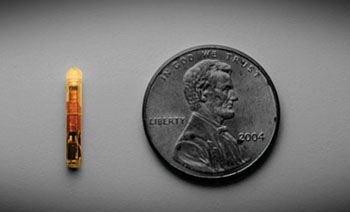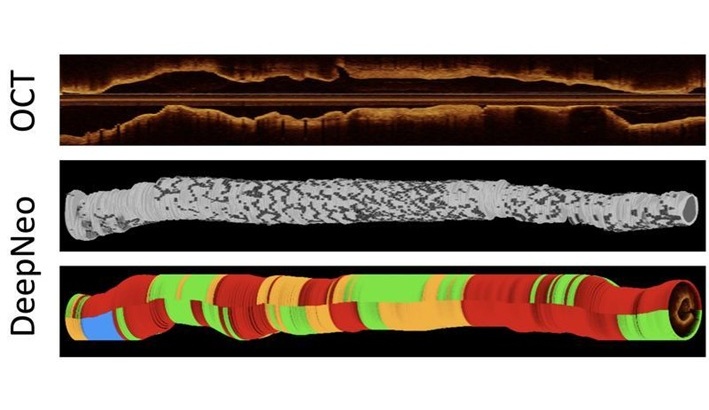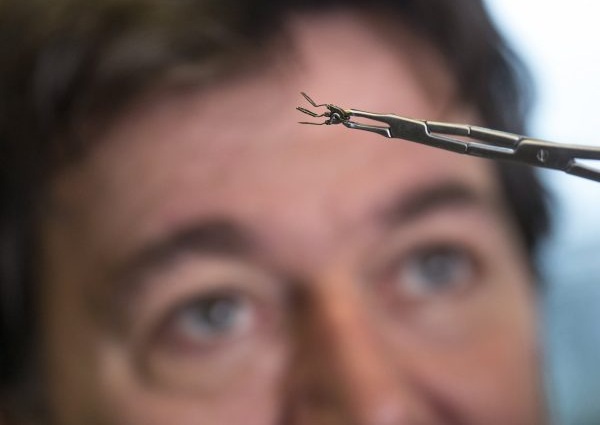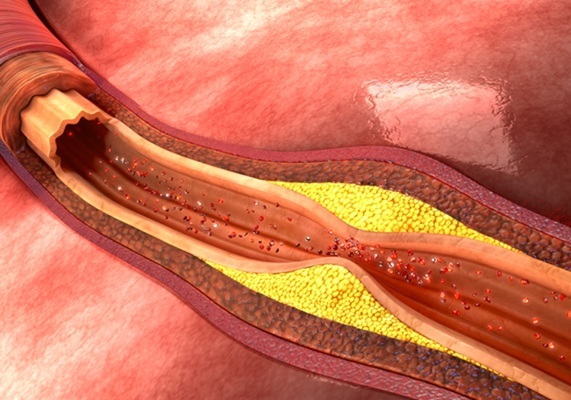New Breast Implants Contain RFID Technology
|
By HospiMedica International staff writers Posted on 02 Mar 2014 |

Image: The Q Inside Safety Technology RFID chip (Photo courtesy of VeriTeQ Corporation).
Breast implants with radiofrequency identification (RFID) chips can be simply externally scanned for retrieval of information in the event of a recall or other product query.
The Motiva Implant Matrix VelvetSurface PLUS and SilkSurface PLUS breast implants are a made of a soft, gliding, printed nanosurface that reduces complications related to traditional textures, while at the same time reducing capsular contracture rates. The VelvetSurface PLUS implants also provide a printed microsurface that promotes a more secure fit in the breast pocket. Both breast implants are provided with Q Inside Safety Technology, which acts as an electronic serial identification number in breast implants and other implantable and reusable medical devices.
Manufacturers, physicians, and patients alike will have access to a secure online database to retrieve implant-specific data such as serial number, manufacturer name, date of manufacture, lot number, volume, size, and other data from the medical device manufacturer. The Motiva Implant Matrix VelvetSurface PLUS and SilkSurface PLUS breast implants are products of Establishment Labs (Alajuela, Costa Rica). Q Inside Safety Technology was developed by VeriTeQ Corporation (DelRay Beach, FL, USA), a provider of implantable medical device identification and radiation dose measurement technologies.
“We continue to advance the safety and exclusivity of our entire breast implant portfolio to answer the demands from both physicians and patients alike,” said Juan José Chacón-Quirós, CEO of Establishment Labs. “Including VeriTeQ’s Q Inside Safety Technology in Motiva’s SilkSurface PLUS and VelvetSurface PLUS implants emphasizes our primary focus of providing best-in-class products for the protection of the patient.”
“Giving physicians and patients the power to identify their breast implants in a healthcare setting is the next generation of technology and security, and we believe both groups will ultimately demand this level of safety from their implants,” said Scott R. Silverman, chairman and CEO of VeriTeQ.
A example highlighting the need for breast implant identification occurred in 2010, when a French manufacturer of breast implants named PIP was shut down because the company used industrial grade silicone in their implants instead of medical-grade silicone, which had double the rupture rate of other implants. As news of leaks spread, breast implant patients were concerned that they may have PIP's implants. Many of the patients did not have product or warranty cards, and no records were available on which implants were inside each patient.
Related Links:
Establishment Labs
VeriTeQ Corporation
The Motiva Implant Matrix VelvetSurface PLUS and SilkSurface PLUS breast implants are a made of a soft, gliding, printed nanosurface that reduces complications related to traditional textures, while at the same time reducing capsular contracture rates. The VelvetSurface PLUS implants also provide a printed microsurface that promotes a more secure fit in the breast pocket. Both breast implants are provided with Q Inside Safety Technology, which acts as an electronic serial identification number in breast implants and other implantable and reusable medical devices.
Manufacturers, physicians, and patients alike will have access to a secure online database to retrieve implant-specific data such as serial number, manufacturer name, date of manufacture, lot number, volume, size, and other data from the medical device manufacturer. The Motiva Implant Matrix VelvetSurface PLUS and SilkSurface PLUS breast implants are products of Establishment Labs (Alajuela, Costa Rica). Q Inside Safety Technology was developed by VeriTeQ Corporation (DelRay Beach, FL, USA), a provider of implantable medical device identification and radiation dose measurement technologies.
“We continue to advance the safety and exclusivity of our entire breast implant portfolio to answer the demands from both physicians and patients alike,” said Juan José Chacón-Quirós, CEO of Establishment Labs. “Including VeriTeQ’s Q Inside Safety Technology in Motiva’s SilkSurface PLUS and VelvetSurface PLUS implants emphasizes our primary focus of providing best-in-class products for the protection of the patient.”
“Giving physicians and patients the power to identify their breast implants in a healthcare setting is the next generation of technology and security, and we believe both groups will ultimately demand this level of safety from their implants,” said Scott R. Silverman, chairman and CEO of VeriTeQ.
A example highlighting the need for breast implant identification occurred in 2010, when a French manufacturer of breast implants named PIP was shut down because the company used industrial grade silicone in their implants instead of medical-grade silicone, which had double the rupture rate of other implants. As news of leaks spread, breast implant patients were concerned that they may have PIP's implants. Many of the patients did not have product or warranty cards, and no records were available on which implants were inside each patient.
Related Links:
Establishment Labs
VeriTeQ Corporation
Latest Health IT News
- Printable Molecule-Selective Nanoparticles Enable Mass Production of Wearable Biosensors
- Smartwatches Could Detect Congestive Heart Failure
- Versatile Smart Patch Combines Health Monitoring and Drug Delivery
- Machine Learning Model Improves Mortality Risk Prediction for Cardiac Surgery Patients
- Strategic Collaboration to Develop and Integrate Generative AI into Healthcare
- AI-Enabled Operating Rooms Solution Helps Hospitals Maximize Utilization and Unlock Capacity
- AI Predicts Pancreatic Cancer Three Years before Diagnosis from Patients’ Medical Records
- First Fully Autonomous Generative AI Personalized Medical Authorizations System Reduces Care Delay
- Electronic Health Records May Be Key to Improving Patient Care, Study Finds
- AI Trained for Specific Vocal Biomarkers Could Accurately Predict Coronary Artery Disease
Channels
Critical Care
view channel
AI Model Analyzes Patient Data to Diagnose Multiple Sclerosis With 90% Accuracy
Multiple sclerosis (MS) is a chronic inflammatory condition affecting the central nervous system. Most patients initially experience the relapsing-remitting form (RRMS), characterized by periods of symptom... Read more
Magnetically Navigable Microparticles Enable Targeted Drug Delivery
Abdominal aortic aneurysms (AAA) can be life-threatening if not treated and result in nearly 10,000 deaths annually. Researchers working to improve treatments for AAA could now make it possible for doctors... Read more
AI-Powered Algorithm Automates Analysis of Coronary Stents After Implantation
Every year, over three million people globally receive stents to open blocked blood vessels caused by heart disease. However, monitoring the healing process after stent implantation remains a significant challenge.... Read moreSurgical Techniques
view channel
DNA Origami Improves Imaging of Dense Pancreatic Tissue for Cancer Detection and Treatment
One of the challenges of fighting pancreatic cancer is finding ways to penetrate the organ’s dense tissue to define the margins between malignant and normal tissue. Now, a new study uses DNA origami structures... Read more
Pioneering Sutureless Coronary Bypass Technology to Eliminate Open-Chest Procedures
In patients with coronary artery disease, certain blood vessels may be narrowed or blocked, requiring a stent or a bypass (also known as diversion) to restore blood flow to the heart. Bypass surgeries... Read more
Intravascular Imaging for Guiding Stent Implantation Ensures Safer Stenting Procedures
Patients diagnosed with coronary artery disease, which is caused by plaque accumulation within the arteries leading to chest pain, shortness of breath, and potential heart attacks, frequently undergo percutaneous... Read more
World's First AI Surgical Guidance Platform Allows Surgeons to Measure Success in Real-Time
Surgeons have always faced challenges in measuring their progress toward surgical goals during procedures. Traditionally, obtaining measurements required stepping out of the sterile environment to perform... Read morePatient Care
view channel
Portable Biosensor Platform to Reduce Hospital-Acquired Infections
Approximately 4 million patients in the European Union acquire healthcare-associated infections (HAIs) or nosocomial infections each year, with around 37,000 deaths directly resulting from these infections,... Read moreFirst-Of-Its-Kind Portable Germicidal Light Technology Disinfects High-Touch Clinical Surfaces in Seconds
Reducing healthcare-acquired infections (HAIs) remains a pressing issue within global healthcare systems. In the United States alone, 1.7 million patients contract HAIs annually, leading to approximately... Read more
Surgical Capacity Optimization Solution Helps Hospitals Boost OR Utilization
An innovative solution has the capability to transform surgical capacity utilization by targeting the root cause of surgical block time inefficiencies. Fujitsu Limited’s (Tokyo, Japan) Surgical Capacity... Read more
Game-Changing Innovation in Surgical Instrument Sterilization Significantly Improves OR Throughput
A groundbreaking innovation enables hospitals to significantly improve instrument processing time and throughput in operating rooms (ORs) and sterile processing departments. Turbett Surgical, Inc.... Read moreBusiness
view channel
Expanded Collaboration to Transform OR Technology Through AI and Automation
The expansion of an existing collaboration between three leading companies aims to develop artificial intelligence (AI)-driven solutions for smart operating rooms with sophisticated monitoring and automation.... Read more














